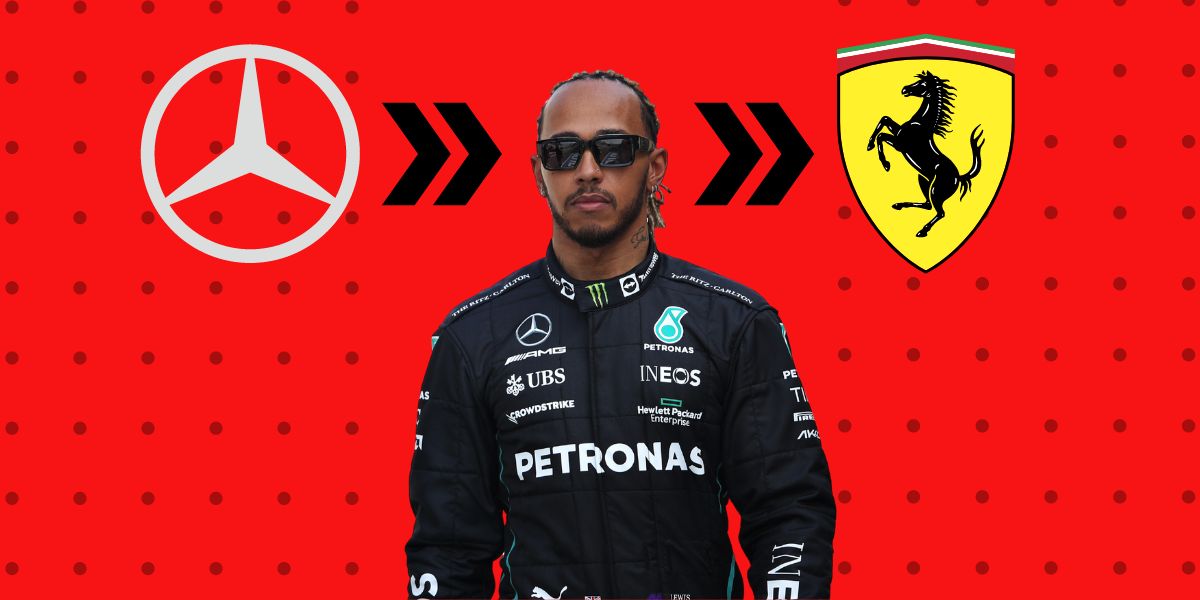10 Questions About Lewis Hamilton’s Stunning Move to Join Ferrari
Why would Hamilton choose to leave Mercedes for Ferrari? What ripple effects could it have for the rest of the grid? And is this the biggest driver move in F1 history?

The F1 world completely shifted on Thursday. Lewis Hamilton announced that he will leave Mercedes after the 2024 season and join Ferrari—the biggest, baddest, and most historic name in the sport—on a multiyear deal. This seismic event is already reshaping the driver landscape of F1: Hamilton has just one more season with the team he’s won six championships for; Carlos Sainz will soon be looking for a new gig; and Charles Leclerc will have new in-house competition after recently signing an extension with Ferrari. Meanwhile, Mercedes team principal Toto Wolff is probably sending out frantic emails trying to determine where the Silver Arrows go from here.
Just a day after it seemed like F1’s rejection of Michael Andretti’s bid to join the grid would be the biggest news of the offseason, Hamilton and Ferrari made that development look like small potatoes. They also raised a ton of questions. Here are 10 to help make sense of this stunning monster move.
Wait, what just happened?
Yeah. My question exactly. Rumors about Hamilton going to Ferrari started spreading on Wednesday night for those who live in the United States; by Thursday morning, those rumors had solidified into reports that a deal was done. Mercedes confirmed Lewis’s eventual departure in a statement in which Hamilton said, “I have had an amazing 11 years with this team and I’m so proud of what we have achieved together. Mercedes has been part of my life since I was 13 years old. It’s a place where I have grown up, so making the decision to leave was one of the hardest decisions I have ever had to make. But the time is right for me to take this step and I’m excited to be taking on a new challenge.”
Ferrari followed that up with a … succinct statement of their own:
So yes, it’s happening, despite the fact that it all still feels like a fever dream.
We’ve heard rumors of Hamilton going to Ferrari in the past. What was different this time?
This is a question for Lewis directly, but it’s an interesting one given how many times we’ve seen reports linking him to Ferrari over the years. Just last May, scuttlebutt surrounding such a move was a major topic of conversation leading into the Monaco Grand Prix—to the point where both Hamilton and Ferrari team principal Fred Vasseur were asked to comment. Hamilton said, “Naturally when you’re in the contract negotiations, there’s always going to be speculation. I think ultimately, unless you hear from me, then that’s what it is.” When asked directly if he’d had any contact with Ferrari, he said, “No.”
Vasseur echoed the sentiment, saying: “At this stage of the season, you will have each week a different story [about the drivers]. We are not sending an offer to Lewis Hamilton. We didn’t do it. We didn’t have discussions.”
It’s easy to take both at their word: Hamilton, after all, signed a two-year contract with Mercedes in August (which reportedly included an exit clause that he exercised in advance of 2025). And just last month it appeared that Ferrari was still negotiating with Sainz on a new deal before his existing one expired at the end of 2024.
So what ultimately brought Hamilton and Ferrari together? For now, all we have to go off are theories. Maybe Ferrari made Hamilton a monetary offer he couldn’t refuse and have a solid plan for 2025, and for 2026, when F1 teams will have to change their cars under new regulations. Maybe Hamilton saw what Mercedes has planned and didn’t feel it was enough to challenge Max Verstappen and Red Bull. Maybe Hamilton has always wanted to drive for Ferrari, and the stars just happened to align this time. Maybe he just really likes the color red.
Regardless of the reasoning, what’s different this time is that the rumors were true. This makes for a wild new reality in F1.
Is this the biggest, most surprising driver move in F1 history?
It very well could be. Top-tier drivers don’t tend to change teams a ton in their primes. (Despite the fact that Hamilton will be 40 by the time this deal kicks in, I will only believe that he’s past his prime when he retires.) And Hamilton is more than just a top-tier driver—he’s the best driver in Formula 1 history, the most famous driver on the grid, and one of the top brands in all of sports, full stop. Now he’s going to the most storied F1 team there is.
Some have said this is the biggest F1 driver move since Hamilton left McLaren in 2013—where he’d won a championship in 2008—to join Mercedes. Others have gone outside of F1 with their comparisons, likening this to Tom Brady leaving the New England Patriots and going on to win a Super Bowl with the Tampa Bay Buccaneers. But even that doesn’t feel right: Brady would have had to join a team like the Dallas Cowboys to get to the Ferrari level, and the Pats and Cowboys haven’t been in a heated rivalry with each other over the years like Ferrari and Mercedes have. Even last year, Mercedes beat Ferrari for second place in the constructors’ championship by three points. Ferrari consistently finished second to Mercedes across the back half of the 2010s.
This has to sting for Mercedes fans, and it has to put a jig in the step of the Tifosi, who over the last few seasons have been known more for their existential fan accounts on Twitter than wins on the racetrack. Congrats to Italy.
Why would Hamilton decide to do this, and is it the right move?
There are a number of reasons Hamilton could want to do this now. Let’s start with the most practical. Hamilton could simply be displeased with Mercedes’ progress post-2021 and lacks belief in their vision for the car going forward. After all, this team severely flubbed its redesign for 2022 and has been playing catch-up ever since. Last year, Mercedes finally admitted their sidepod design wasn’t working and overhauled it—in the middle of the season! Discussing the car early this year, Wolff admitted, “The W13 was my biggest mistake in recent years. We took the wrong approach to building the car for the 2022 season, it wasn’t the correct path.
“Confirming this concept in 2023 was the second big mistake.”
So maybe that’s all it is—Lewis saw what Mercedes had planned, decided it wasn’t enough, and figured Ferrari offered him a chance for a new start with an equally competitive outfit. Maybe the move speaks to the strength of Hamilton’s relationship with Vasseur, who he’s known since his junior racing career, and Ferrari executive chairman John Elkann, who, as The Athletic’s Luke Smith reported on Thursday, has long loved the idea of signing the seven-time champion.
Or maybe the explanation is more idealistic, and Hamilton dreams of bringing Ferrari back to the top of the sport and putting the ultimate feather in his cap by winning an eighth championship (which would pass Michael Schumacher for the most all time) with a third team. This is a much taller order. It’s been a tough decade and a half for Ferrari. They haven’t won a constructors’ championship since 2008; they haven’t won a drivers’ championship since 2007. They brought Vasseur in last year to replace Mattia Binotto, right the ship, and return common sense and reliability to the team—but on race weekends they’ve still been prone to mess up a strategy decision or have their drivers complain on the radio about tire wear or why they’re being asked to choose from a filing cabinet of race plans.
If legacy is the reason Hamilton decided to make the leap, assessing whether this is the right move for him may come down to Ferrari avoiding more races like Monaco 2022.
What does this mean for Ferrari going forward?
They’ll probably have the best driver pairing on the grid! I say “probably” because, at this point, over half the grid doesn’t currently have drivers locked down beyond 2024 (more on that later). But the only potential pairing that could be spicier and more exciting than this one in 2025 would be if Red Bull hired Fernando Alonso to go with Max Verstappen, or if Carlos Sainz went on a revenge tour, re-signed with Red Bull, and started regularly beating the Dutchman. So my money’s on Hamilton-Leclerc.
Outside of that, though, a lot is up in the air. Ferrari’s car looked great in qualifying last year, earning P1 six times, but it struggled with race pace and especially with tire management. The hope has to be that they can get the 2025 car to a place where it’s competitive with Red Bull, and that they nail their regulation changes for 2026. Hamilton certainly doesn’t have time to wait for them to figure things out beyond that, and if Ferrari is hoping to get back in the constructors’ fight, it can’t waste a driver duo like this.
The first order of business will be developing a car that protects its tires better, is more reliable than recent iterations, and still has those bursts of speed. That’ll be the only chance they have at going after Red Bull.
What does it mean for Mercedes?
This one’s tougher. It certainly doesn’t seem to mean good things. The team’s biggest star—the sport’s biggest star—will no longer be in their garage. The heights they achieved with Hamilton will be incredibly difficult to replicate, and they’ll have to do so without a world-beating car like they had from 2014 to 2020. The clearest path forward now is trying to maximize their last season with Hamilton, get more consistency from the car week-to-week, and hope that a solid showing makes them attractive to drivers who may want to fill their second seat. Otherwise, Wolff may have to [gulp] take Red Bull team principal Christian Horner’s advice and actually “change his fucking car.”
How happy is George Russell right now?
My guess is that he spent the early afternoon doing cartwheels around his Monégasque flat. Seriously, though, this is likely the moment, and the stage, Russell has been waiting for. When he left Williams to join Mercedes in 2022, his stated goal was to deliver “week in and week out, scoring wins, pole positions and helping win multiple championship titles.” A lot of that talk is what you’d expect out of any young driver going from a back-of-the-field team to a contender, but in Russell’s case, that was genuinely the expectation. In 2022, Mercedes was coming off eight straight constructors’ championships and a year in which Hamilton would have won his eighth drivers’ championship had Abu Dhabi been a normal race. Yet both Russell and the team have fallen short of those goals in the last two seasons.
The first year wasn’t Russell’s fault. The 2022 Mercedes car was notoriously problematic, porpoising all over the track to the point that Hamilton was crawling out of his car at the end of races because it was so painful on his back. It wasn’t a very competitive machine, and yet Russell still managed to finish fourth in the drivers’ championship. Last season, though, he seemed to be pushing too hard, and he suffered the consequences. He hit a wall in the Canadian Grand Prix trying to catch Fernando Alonso; he DNF’d in Singapore; he turned in on Verstappen in the inaugural Vegas race; and he put a whole lot of energy into trying to outdo Hamilton. Which makes sense—all F1 drivers are competitive, and the only person they’re racing on equal machinery is their teammate. They always want to beat their teammate. But when your teammate is Lewis Hamilton, that pressure can be overwhelming. Russell finished eighth in the championship last season, 59 points and five places behind Lewis.
Russell will have one more year to go up against Hamilton, and then he’ll have a new challenge. Whether Mercedes makes George their full-fledged no. 1 driver after Hamilton departs remains to be seen—but Russell can do himself a lot of favors by having a bounceback 2024.
Who will Mercedes bring in alongside Russell?
There are so many options! As I said above, only six drivers are currently locked in with their teams beyond 2024: Verstappen, Leclerc, Hamilton, Lando Norris, Oscar Piastri, and Russell. If we assume that Red Bull goes with someone in-house for their second seat (whether that be Chéco Perez, Daniel Ricciardo, Yuki Tsunoda, or Liam Lawson), and that Lance Stroll stays with Aston Martin, that leaves 12 drivers without a team for 2025—and those are just the ones currently on the grid.
My favorite target for Mercedes would be Fernando Alonso, for both personal and professional reasons. For one thing, he’s incredibly fun to watch while driving for a competitive team. Early last year, when Aston Martin shot out of the gate and briefly looked like a challenger, he got every last thing he could out of that car and had a series of podium finishes. Imagine what he could do with an improved Mercedes!
Alonso would also bring some of the gravitas that Mercedes will lose without Hamilton. Alonso is a Formula 1 champion in his own right, and while it’s been 18 years since he’s won a title, I fully believe he has the instincts to get back there in the right circumstance.
Other fun options: Sainz, who could simply swap seats with Hamilton; Alex Albon, who is a dark horse contender after what he did at Williams last season; Pierre Gasly, who has had a more muted career than I expected (partially due to Alpine’s belly flop last season), but who could be interesting in a competitive car once again. Or there’s Andrea Kimi Antonelli, who’s in the Mercedes junior pipeline and looks to be an incredibly exciting prospect.
Basically there are a ton of ways this could go, and a ton of ways Mercedes could get it right—or wrong.
Where does Carlos Sainz go from here?
Again, there are so many options out there. Would he ever reunite with Horner and Red Bull? Take Lewis’s vacant seat at Mercedes? Join a mid-tier team and hope for a renaissance? If the latter happens, the most likely choice would seem to be Stake F1 (formerly Alfa Romeo), the Sauber team which is set to join with Audi ahead of the 2026 season. Sainz has connections to Audi—his father, Carlos Sainz Sr., has raced Audis in rally car events. And there have been rumors that the German brand is interested in Sainz for 2026. What’s the harm in starting the partnership a year early?
Did this just set off one of the silliest silly seasons in F1 history?
Hell yeah, brother. Buckle in!





